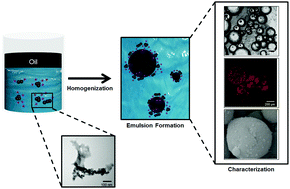Magnetically-active Pickering emulsions stabilized by hybrid inorganic/organic networks†
Abstract
Magnetically-active hybrid networks (MHNs) are complex inorganic/organic composite materials that have been synthesized from the coupling of amine-functionalized iron oxide nanoparticles (amine-IONs) and pre-assembled shell crosslinked knedel-like (SCK) polymeric nanoconstructs. The intricate structure of these materials is composed of several inter-connected bundles of SCKs covalently bound to amine-IONs, which afford them magnetic responsivity. The MHNs were originally designed to sequester complex hydrocarbons from water; however, they have displayed a remarkable ability to form stable Pickering emulsions between organic solvents and water, upon mechanical stimulus. Two methods of emulsification, vortex and probe sonication, have been utilized to yield magnetically-active toluene-in-water and dodecane-in-water emulsions, which are stable for up to two months in the presence of the MHNs. A detailed study of the effect of the water-to-oil (W : O) volume ratio and the MHN concentration on the droplet size of the emulsions revealed that the smallest droplet size, and narrowest dispersity were obtained at a W : O = 3 : 1, for all conditions tested. Additionally, concentrations of MHNs as low as 1 mg mL−1 and 1.5 mg mL−1, for emulsions prepared via vortex and probe sonication, respectively, were sufficient to yield the smallest droplets and narrowest distributions. Furthermore, the oil droplets stabilized by the MHNs exhibited magnetic character, and could be manipulated with an external magnetic field.


 Please wait while we load your content...
Please wait while we load your content...